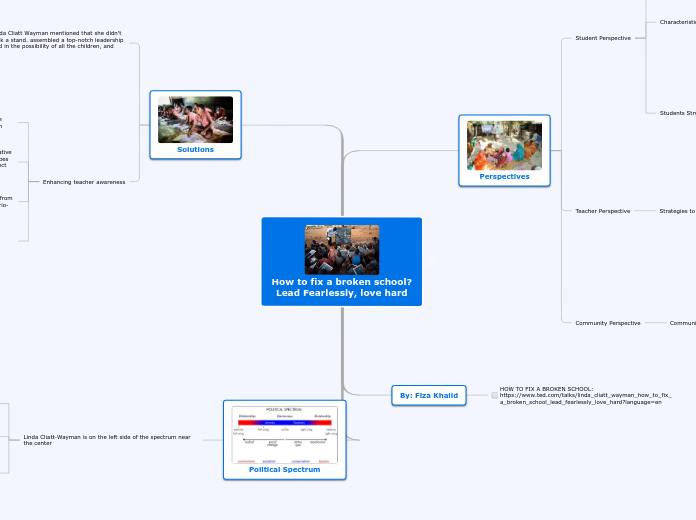How to fix a broken school?
Lead Fearlessly, love hard
Perspectives
Student Perspective
Basic need of students have not been established, and the students do not have an expectation for what their needs really are
Their basic needs overshadow their ability to focus on learning to their fullest potential.
Characteristics of Students in Poverty:
Hunger, Domestic Violence, Alcoholism/drug abuse, missing parents, lack of sleep, physical appearance (dirty or torn clothing), strained emotions, homelessness, difficulty focusing.
Mental Health
Stress
Illnesses
Anxiety
Depression
Students Struggles in the Classroom Setting
Academic Struggles: inability to focus academically
the acute chronic stress associated with poverty often leads to diminished cognitive control.
Social Struggles: Limiting of social activities embarrassment, strained emotions
Behaviour Struggles: "Acting-out", impatience, impulsiveness, gaps in politeness, inappropriate emotional responses, lack of empathy
Other Struggles: Loss of transportation, less nutritionally balanced meals
Teacher Perspective
Strategies to support students in poverty
Understand that a student's emotional and social outbursts are not due to rudeness or lack or manner. "Teachers do not simply need to look like students in poverty themselves. I believe teachers need to care." (Jenson, 2014)
Find ways to help the students reach their potential. Help students to understand that the classrooms short term content goals lead to their long term goals of opportunity
Kids living in poverty need ore supports tat upper-class children need to thrive: small classes, challenging, rich curriculum, individualised instruction, supportive response to emotional and behavioural challenges
Teach them the hidden middle-class rules that will make them successful at school and work. We can not scold them for not knowing, we must teach the and provide support, insistence, and expectations.
Community Perspective
Communities has a lot of resources to help families in poverty.
CHILDREN AND FAMILY OPTIONS
Boys & Girls Clubs of America - Many programs for kids, including education, fitness, social recreation, bullying prevention, community outreach, childcare, and more.
YMCA - Programs for youth development, healthy living, and social responsibility
EMPLOYMENT ASSISTANCE
CareerOneStop - Sponsored by the U. S. Department of Labour,Employment and Training Administration
Dress for Success - provides women who are re-entering the work force with interview-appropriate clothing and shoes, as well as advice on how to ace that interview.
By: Fiza Khalid
HOW TO FIX A BROKEN SCHOOL: https://www.ted.com/talks/linda_cliatt_wayman_how_to_fix_a_broken_school_lead_fearlessly_love_hard?language=en
Solutions
From the talk, Linda Cliatt Wayman mentioned that she didn't stay quiet and took a stand. assembled a top-notch leadership team who believed in the possibility of all the children, and together.
They tackled the small things, like resetting every single locker combination by hand so that every student could have a secure locker.
They decorated every bulletin board in that building with bright, colourful, and positive messages. We took the chains off the front doors of the school.
They got the lightbulbs replaced, and we cleaned every classroom to its core, recycling every, every textbook that was not needed, and discarded thousands of old materials and furniture. We used two dumpsters per day.
Enhancing teacher awareness
Plan sessions that explore poverty and its conditions, associated stereotypes and impact on schooling.Encourage teachers to look beyond the visible conditions of poverty in order to reframe their thinking and adapt their teaching.
Encourage school teams to engage in site-based, collaborative inquiry to explore preconceived assumptions and stereotypes associated with families living in poverty as well as to reflect on their practices in classrooms and schools.
Involve faculty of education researchers and resource personnel from school districts, incorporate programming from federations in focused professional learning or share Ontario-based research and resources on poverty.
Whether in urban, suburban, rural, or remote school communities, educators working in schools need to understand the context of their workplace and of the community that surrounds it.
Political Spectrum
Linda Cliatt-Wayman is on the left side of the spectrum near the center
She believes that education is a right that all children should have
“Democrats know that every child, no matter who they are, how much their families earn, or where they live, should have access to a high-quality education, from preschool through high school and beyond.”
The economic plans offered by potential 2020 Democratic presidential candidates are much more targeted at low-income households than Barack Obama’s proposed tax cut in 2008.
This shows that Democratics are very serious about helping both the poor and middle class which is also what Linda-Cliatt Wayman is passionate about.
